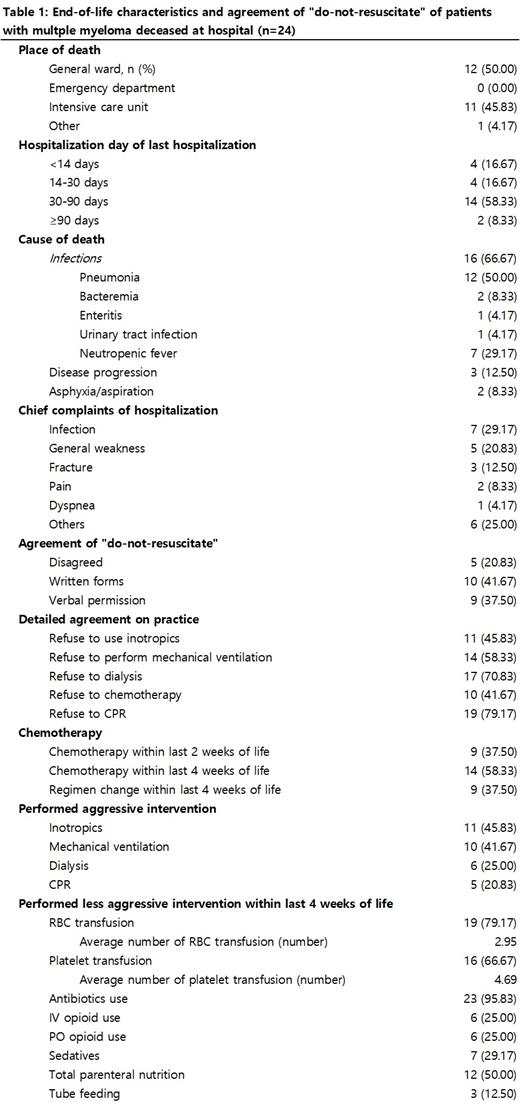Abstract
Background
Multiple myeloma (MM) is a plasma cell malignancy of which the median age at diagnosis is 70 years old. The novel agents had contributed significant improvement in the overall survival of MM. However, there is a disparity in survival between young and old patients, and early mortality is high in patients older than 70. Therefore, before making a treatment plan for elderly MM patients, it is crucial to consider both quality of life and even end-of-life (EOL) care. This study evaluated EOL characteristics and real-world supportive care in elderly MM patients.
Methods
We retrospectively reviewed medical records of patients diagnosed with MM at an age older than 70 between January 2011 and April 2021. We identified baseline characteristics, symptom burdens, factors associated with hospitalizations during the disease course, and several indicators of EOL; place of death, length of hospitalization, cause of death, chief complaints, agreement of "do-not-resuscitate (DNR)", other aggressive and less aggressive interventions in their last hospitalization.
Result
A total of 52 patients were included. The median age at diagnosis is 76 years old. 12 (23.08%) patients showed initial Eastern cooperative oncology group (ECOG) performance status 3 or 4. 30 (57.69%) patients had hypertension, 18 (34.62%) had diabetes, and 8 (15.38%) had chronic lung disease; asthma, COPD, and bronchiectasis. 3 (5.77%) patients had initial International staging system (ISS) stage 1 disease, 16 (30.77%) had 2, and 29 (55.77%) had 3. Only 2 (3.85) patients never received chemotherapy; one of them showed initial ECOG 3, and the other was unknown. The median overall survival was 16.69 months.
27 (51.92%) patients visited the emergency department during their disease course at least once, and 19 (36.54%) were admitted intensive care unit more than once. Only 4 (7.59%) patients were never admitted hospital during their disease course except for chemotherapy. The mean number of hospitalization was 3.23, and the reason for 41.67% of hospitalization was to control myeloma-related symptoms; general weakness, acute kidney injury, pain, fracture, cord compression, and anemia. The rate of hospitalization day after diagnosis was 9.85%.
The EOL characteristics of 24 (46.15%) deceased at the hospital were analyzed. An average hospitalization length was 41.96 days. Other EOL characteristics are detailed in table 1.
Conclusion
Elderly MM patients spent almost 10% of their disease duration at the hospital to control disease-related symptoms. It might explain why elderly MM patients received aggressive therapy despite their age and poor performance status. To enhance their quality of life, we need to focus more on supportive care and make a decision for chemotherapy carefully. Furthermore, for EOL care, discussion for performing an aggressive intervention with patients should be encouraged.
No relevant conflicts of interest to declare.


This feature is available to Subscribers Only
Sign In or Create an Account Close Modal